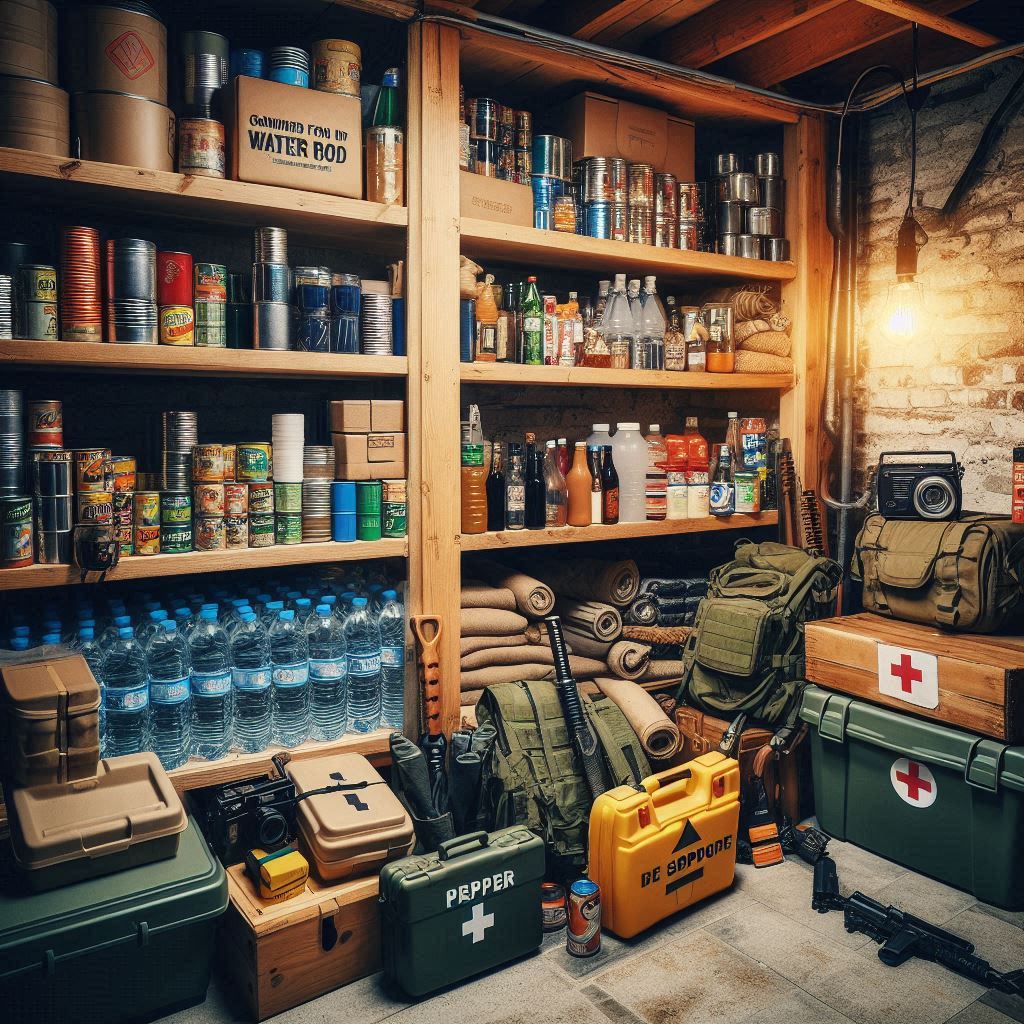Surviving in a desert requires a blend of knowledge, skills, and resourcefulness due to the harsh and unforgiving environment. Deserts are characterized by their extreme scarcity of water, intense heat during the day, and freezing temperatures at night, presenting a unique set of challenges for anyone who becomes lost.
Understanding how to find and conserve water is crucial, as dehydration is the most significant risk. Identifying potential water sources, such as underground springs or natural rock basins, and learning techniques like collecting dew can make a critical difference. Additionally, familiarizing yourself with the native plants and animals, including which are edible and which are dangerous, is essential for sourcing food and avoiding hazards. Knowledge of basic first aid, including treating heatstroke, sunburn, and hypothermia, is also vital to manage injuries and prevent them from becoming life-threatening.
Actions you should take to increase your chances of survival include finding or constructing shelter to protect yourself from the extreme temperatures. Use natural formations like caves or rock overhangs to provide shade during the day and insulation at night, or build a shelter using materials like branches, rocks, and your clothing. Conserve your energy by resting during the hottest part of the day and performing necessary tasks in the cooler early morning or late afternoon hours. Use reflective materials or create large ground signals to attract the attention of rescuers and stay oriented by using the position of the sun during the day and constellations at night. Maintaining a positive attitude is crucial, as panic can lead to poor decisions and faster depletion of resources. By staying calm, assessing your situation rationally, and using your skills and knowledge effectively, you can increase your chances of being found and returning safely from the desert.
What You Need to Know
Understanding the Environment:
- Temperature Extremes: Deserts experience extreme temperature fluctuations, characterized by scorching heat during the day, where temperatures can soar above 100°F (38°C), and freezing temperatures at night, often dropping below 32°F (0°C). These drastic changes require careful preparation, as the intense daytime heat increases the risk of heatstroke and dehydration, while the cold nights can lead to hypothermia if not properly managed. To survive, you must dress in layers, use available materials for insulation, and build shelters that provide shade during the day and retain warmth at night.
- Water Scarcity: Deserts are defined by their extreme scarcity of water, making the ability to locate and conserve water crucial for survival. Learn to identify potential water sources such as underground springs, natural rock basins, or areas where vegetation is unusually green, which can indicate moisture below the surface. Additionally, practice water conservation by rationing your supply, avoiding strenuous activities during peak heat, and employing techniques like collecting dew or using condensation traps to supplement your water needs, ensuring every drop is used efficiently.
- Desert Flora and Fauna: Familiarize yourself with the plants and animals native to the desert by studying guides or resources that detail which species are safe to eat and which pose risks. Learn to identify edible plants, such as certain cacti and succulents, which can provide hydration and nutrients, and recognize harmful species like the toxic desert nightshade. Additionally, understand the behavior and habitats of dangerous animals, such as venomous snakes and scorpions, to avoid potentially life-threatening encounters and know which small animals and insects are safe to hunt and consume for sustenance.
Basic Navigation:
- Natural Landmarks: Learn to identify natural landmarks such as mountains, rock formations, and clusters of vegetation, which can serve as reliable points of reference in the vast desert landscape. Mountains and large rock formations are often visible from great distances and can help you maintain a consistent direction as you travel. Clusters of vegetation, particularly those that indicate the presence of water, can guide you toward essential resources while providing markers to track your progress and avoid disorientation.
- Sun and Stars: Use the position of the sun during the day to help with orientation by observing its movement from east to west, which can provide a general sense of direction. In the morning, the sun rises in the east, and in the evening, it sets in the west, allowing you to align your path accordingly. At night, use constellations such as the North Star in the Northern Hemisphere, which remains relatively fixed in the sky, to navigate and maintain your course, ensuring you stay oriented and avoid wandering in circles.
Health Risks:
- Dehydration: The most significant risk in a desert is dehydration, which can quickly become life-threatening due to the lack of water and extreme heat. Recognize the early signs of dehydration, including extreme thirst, dizziness, and dark-colored urine, indicating that your body is conserving water. To combat dehydration, prioritize finding and rationing water, drink small sips regularly to keep hydrated, and avoid strenuous activities during the hottest parts of the day to minimize water loss through sweating.
- Sunburn and Heatstroke: Prolonged exposure to the sun can cause severe sunburn, leading to painful, blistered skin, and heatstroke, which can be life-threatening due to the body’s inability to regulate its temperature. Learn to recognize the symptoms of heatstroke, such as dizziness, confusion, rapid heartbeat, and nausea, and treat it by moving to a shaded area, cooling the body with water, and fanning to promote evaporation. For sunburn, protect affected skin by covering it with loose, light clothing, applying cool compresses, and drinking plenty of fluids to stay hydrated and aid the healing process.
- Hypothermia: Despite the intense heat experienced during the day, desert nights can become dangerously cold, with temperatures dropping drastically, sometimes to near freezing. This sudden change increases the risk of hypothermia, as your body struggles to maintain its core temperature in the absence of sufficient warmth. To mitigate this risk, use all available clothing and insulation materials, such as leaves or even sand, to trap body heat and stay warm throughout the night, ensuring you are adequately prepared for the significant temperature fluctuations.
Actions to Take for Survival
Finding and Conserving Water:
- Locate Water Sources: Look for signs of water such as green vegetation, which often indicates the presence of moisture below the surface. Animal tracks can also lead you to water sources, as many animals in the desert know where to find water and will frequent these spots regularly. Additionally, search low-lying areas or depressions in the landscape where water might collect after rainfall, and consider digging in these areas to access hidden moisture.
- Water Conservation: Ration your water supply carefully by drinking small, controlled sips instead of large gulps to make it last longer. Avoid unnecessary exertion during the hottest part of the day, typically between late morning and late afternoon, to minimize sweating and reduce water loss. Seek shade and rest during these peak heat hours, and plan any essential physical activities for the cooler early mornings or late evenings to conserve both energy and hydration.
- Purification: If you find water, ensure it is safe to drink by first filtering out any visible debris using a cloth or improvised filter. Boil the water for at least one minute to kill harmful bacteria and pathogens, or use purification tablets according to the instructions to eliminate any contaminants. If boiling or tablets are not available, use a portable water filter designed for wilderness use, which can effectively remove most bacteria and protozoa, making the water safer to consume.
- Building Shelter: Use natural formations like caves or rock overhangs to provide shade during the day and insulation at night. If none are available, construct a shelter using materials like branches, rocks, and your clothing to create shade and a barrier against the wind and cold. Ensure your shelter is well-ventilated to avoid trapping heat and make it as comfortable as possible to conserve your energy for other survival tasks. In sandy environments, dig a trench to create a cooler sleeping area and line it with vegetation or clothing for insulation. Regularly maintain and reinforce your shelter to withstand the changing conditions and protect yourself from potential hazards like sandstorms.
- Natural Shelter: Use natural formations like caves or rock overhangs to provide essential shade during the day, protecting you from the sun’s intense heat and reducing the risk of sunburn and heatstroke. These formations also offer insulation at night, helping to retain warmth and protect against the drastic temperature drops common in desert environments. Additionally, such shelters can shield you from wind and sandstorms, creating a more stable and secure environment to conserve energy and focus on other survival tasks.
- Improvised Shelter: Construct a shelter using materials like branches, rocks, and your clothing to create a shaded area that protects you from the sun’s intense rays during the day. Arrange branches and rocks to form a sturdy frame, then cover it with clothing, leaves, or other available materials to provide additional shade and insulation. This shelter will also act as a barrier against the wind and cold, especially during the chilly desert nights, helping to maintain your body temperature and shielding you from harsh weather conditions.
Signaling for Help:
- Reflective Devices: Use mirrors, shiny objects, or reflective materials to signal aircraft or distant search parties by catching and reflecting sunlight in their direction. Aim the reflection by holding the reflective surface and angling it to create a bright flash of light that can be seen from miles away. This method is especially effective in the open desert landscape, where the glare can be easily noticed by rescuers, significantly increasing your chances of being spotted and rescued.
- Ground Signals: Create large ground signals by arranging rocks, branches, or other contrasting materials to form clear and visible shapes on the desert floor. Draw an SOS or a large X in the sand, ensuring the lines are thick and deep enough to be seen from the air. These signals should be positioned in open areas where they are not obstructed by vegetation, making them more noticeable to passing aircraft and increasing the likelihood that search and rescue teams will spot you.
- Fire: At night, build a fire to provide essential light and warmth, which can protect you from the cold desert temperatures and deter nocturnal predators. Use dry wood, twigs, and other combustible materials to keep the fire burning steadily. The fire also serves as a vital signal to rescuers, as the bright flames and smoke are easily visible from a distance, especially in the dark, increasing your chances of being located and rescued.
- Finding Food: Look for edible plants such as certain types of cacti, like the prickly pear, which can provide both nutrition and hydration. Hunt for small animals and insects, which are often abundant in desert environments and can be a valuable protein source. Be cautious and avoid consuming unknown plants or animals, as many can be toxic and pose serious health risks.
- Edible Plants and Animals: Identify and consume edible plants such as cacti, particularly the prickly pear, which has both edible pads and fruit that provide hydration and nutrients. When hunting for small animals, look for lizards, rodents, or birds, which can be caught using simple traps or by hand if you’re quick and careful. Additionally, insects like ants and grasshoppers are abundant and nutritious; ensure they are thoroughly cooked to avoid potential parasites or bacteria before consuming them.
- Avoiding Dangerous Species: Stay away from potentially poisonous plants and animals by familiarizing yourself with the dangerous species found in the desert, such as certain cacti with toxic sap or venomous creatures like snakes and scorpions. Educate yourself on which plants and animals are safe to consume, such as specific edible cacti and non-venomous insects, to avoid the risk of poisoning. Always err on the side of caution and, if uncertain, avoid consuming any plant or animal that you cannot positively identify as safe.
Maintaining Physical Health:
- Avoid Overexertion: Conserve energy by resting during the hottest part of the day, typically between 10 AM and 4 PM, when the sun’s intensity is at its peak and physical exertion can quickly lead to dehydration and heat exhaustion. Use this time to stay in the shade, hydrate, and plan your next steps, minimizing movement to avoid excessive sweating. Perform essential survival tasks such as gathering materials, searching for water, or signaling for help during the cooler early morning or late afternoon hours when the temperature is lower and the risk of heat-related illnesses is reduced.
- Protection from Elements: Use clothing strategically to protect yourself from the sun during the day by wearing long sleeves, pants, and a wide-brimmed hat to cover your skin and reduce the risk of sunburn and heatstroke. Opt for light-colored, loose-fitting clothing to reflect sunlight and enhance ventilation, keeping your body cooler. At night, when temperatures drop dramatically, layer your clothing to retain warmth and prevent hypothermia, ensuring that any exposed skin is covered to maintain body heat and protect against the cold desert air.
- First Aid: Be prepared to treat minor injuries with improvised first aid techniques by utilizing available resources such as clothing, plants, and other natural materials. For cuts and abrasions, clean the wound with clean water or a disinfectant if available, and use strips of clean cloth as bandages to protect the area from infection. In case of sprains or fractures, immobilize the affected limb using sticks or sturdy branches as splints, securing them with strips of cloth to reduce movement and prevent further injury while you seek help or wait for rescue.
Mental Preparedness:
- Stay Positive: Maintaining a positive attitude is crucial for survival, as it helps you stay focused, think clearly, and make rational decisions under stress. Panic can cloud your judgment, leading to poor decisions that may compromise your safety, such as wasting valuable energy or misusing limited resources. By staying calm and positive, you can more effectively assess your situation, prioritize your needs, and conserve your energy and supplies, ultimately increasing your chances of survival and rescue.
- Set Goals: Establish small, manageable goals to stay motivated, such as finding shelter, securing water, or signaling for help.
- Mental Resilience: Practice mindfulness and relaxation techniques, such as deep breathing exercises or meditation, to manage stress and maintain mental clarity in a survival situation. Deep breathing can help lower your heart rate and reduce anxiety, enabling you to stay calm and think more clearly. By focusing on the present moment and systematically addressing survival tasks, you can prevent feelings of overwhelm and ensure that you use your energy and resources effectively to enhance your chances of survival.
Using Available Resources:
- Clothing and Gear: Use all available clothing and gear effectively by layering your clothing to regulate body temperature, adding or removing layers to stay warm at night and cool during the day. Utilize items like belts, shoelaces, and straps as makeshift tools or fasteners for building shelters and securing materials. Leverage any tools you have, such as knives, multitools, or even sharp rocks, to aid in food gathering, cutting branches, and creating necessary survival implements to improve your chances of enduring the harsh desert environment.
- Improvisation: Be creative with available resources by thinking outside the box and repurposing everyday items for survival needs. For instance, use a plastic bag to collect dew by tying it around the leaves of a plant overnight, allowing condensation to gather for a small but vital water source. Fashion a shade structure by draping clothing over a framework of sticks or branches, providing much-needed protection from the sun during the day, and creating a more comfortable and cooler resting area.
Final Thoughts
Surviving in a desert is a formidable challenge that requires preparation, knowledge, and adaptability. By understanding the environment, conserving water, building shelter, signaling for help, and maintaining a positive mindset, you can significantly increase your chances of survival. Always prioritize your safety and make calculated decisions to navigate the harsh desert landscape effectively.
Frequently Asked Questions (FAQs)
Q1: What is the most important thing to do first if I get lost in the desert?
A1: The first thing to do is to stay calm and assess your situation. Find a shaded area to rest and conserve energy while you plan your next steps. Prioritize finding water and shelter to protect yourself from the harsh environment.
Q2: How can I find water in a desert?
A2: Look for signs of water such as green vegetation, animal tracks, and low-lying areas where water might collect. If possible, collect dew in the early morning or use a solar still to collect moisture from plants.
Q3: What should I avoid eating in the desert?
A3: Avoid eating unknown plants, berries, or mushrooms unless you are certain they are safe. Many desert plants are toxic. Stick to known edible species like certain cacti and insects.
Q4: How can I protect myself from the sun in the desert?
A4: Use clothing to cover your skin, wear a hat, and create shade if possible. Stay in shaded areas during the hottest parts of the day and avoid strenuous activity to minimize exposure.
Q5: What are the signs of dehydration, and how can I prevent it?
A5: Signs of dehydration include extreme thirst, dark urine, dizziness, and fatigue. Prevent dehydration by drinking water regularly, conserving water, and avoiding activities that cause excessive sweating.
Q6: How can I signal for help in the desert?
A6: Use reflective materials, signal mirrors, or brightly colored clothing to attract attention. Create ground signals using rocks or sand, and make noise with a whistle or by shouting if you see or hear rescuers nearby.
Q7: How should I build a shelter in the desert?
A7: Use natural formations like caves or rock overhangs for shelter. If none are available, construct a shelter with branches, rocks, and clothing to create shade during the day and insulation at night.
Q8: What are the best times of day to travel in the desert?
A8: The best times to travel in the desert are early morning and late afternoon when temperatures are cooler. Avoid traveling during the peak heat of the day to conserve energy and reduce the risk of heatstroke.
Q9: What should I do if I encounter dangerous wildlife in the desert?
A9: Stay calm and slowly back away, giving the animal space to retreat. Avoid sudden movements and try to make yourself appear larger if necessary. Learn to recognize and avoid venomous snakes, scorpions, and other dangerous creatures.
Q10: How can I maintain a positive attitude while lost in the desert?
A10: Focus on small, manageable goals and celebrate each success. Stay hopeful by reminding yourself that rescue is possible. Practice mindfulness and relaxation techniques to manage stress and keep a clear mind.
By following these guidelines and preparing for potential challenges, you can improve your chances of surviving and being rescued when lost in the desert.
















